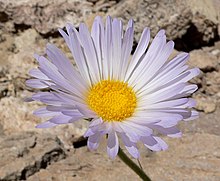|
Xylorhiza tortifolia
Xylorhiza tortifolia is a species of flowering plant in the family Asteraceae, known by the common names Mojave-aster and Mojave woodyaster.[4] DistributionThe flowering plant is native to the Mojave Desert, Sonoran Desert, and Great Basin Desert ecoregions of the southwestern United States, California, and northwestern Mexico.[5] It grows in arid canyons and bajadas/washes, from 240–2,000 metres (790–6,560 ft) in elevation. Habitats it is found in include creosote bush scrub, saltbush scrub, and Joshua tree woodlands.[4] DescriptionXylorhiza tortifolia is a perennial herb or subshrub with branching, hairy, glandular stems that reach 60–80 centimetres (24–31 in) in height/length. The leaves are linear, lance-shaped, or oval, with pointed or spiny tips and spiny edges, while the leaf surfaces are hairy and glandular. The inflorescence is a solitary flower head borne on a long peduncle. The head has a base with long, narrow phyllaries which may be over 2 centimeters long. The head contains up to 60 or more lavender, pale blue, or white ray florets which may be over 3 centimeters long. The bloom period is March through June.[4] The fruit is an achene which may be over a centimeter long, including its pappus of bristles. Varieties
TaxonomyDesert species of this aster with a woody base (Xylorhiza means woody base) are classified under the genus Xylorhiza, and have been removed from the large and complex genus Machaeranthera, where they were placed for many decades.[10] A similar species, Xylorhiza wrightii−Big Bend aster, is native to the Chihuahuan Desert in western Texas and northern Mexico.[10] UsesThe Havasupai used the plant for incense and fragrance, with ground leaves carried in the clothes and used as perfume by men and women to counteract body odors.[11] References
Bibliography
External links
|
||||||||||||||||||||||||||||||||||||

